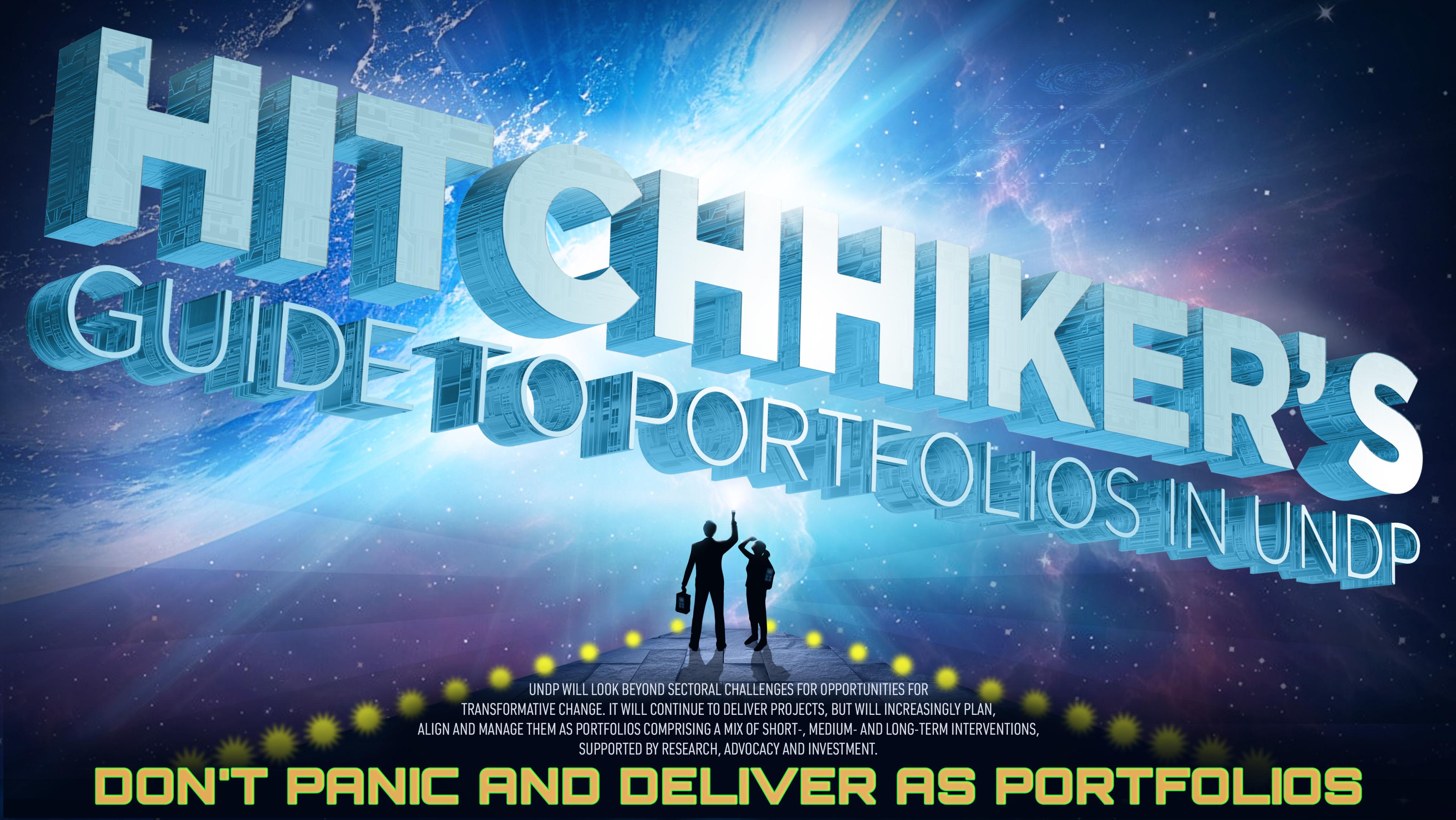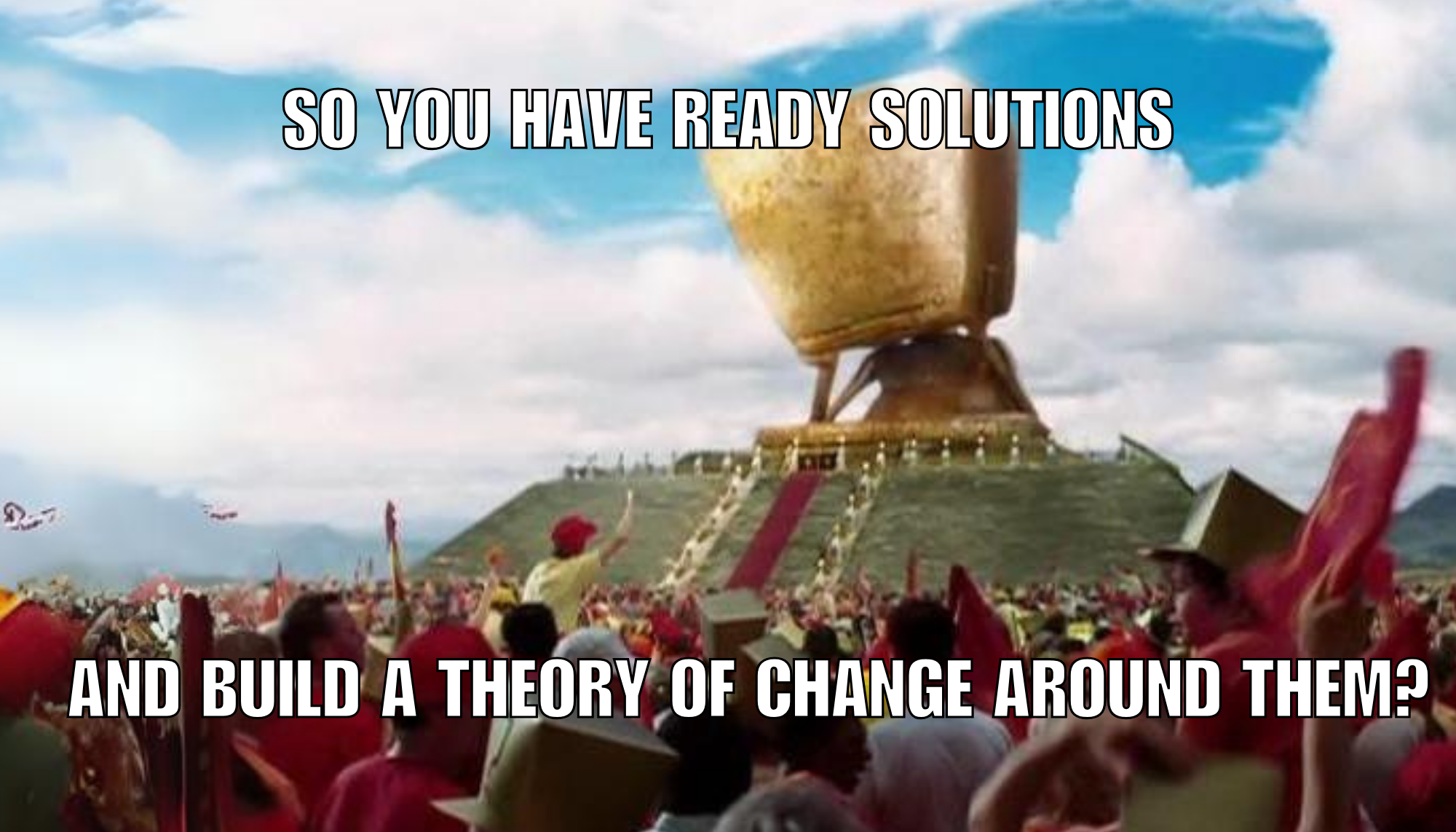Personal Observations from M4EG and other UNDP Portfolios
A Hitchhiker’s Guide to Portfolios in UNDP
April 24, 2024

___________________________________________________________________________________
In 2022-2023, I had the privilege of joining UNDP’s Mayors for Economic Growth (M4EG) for a temporary assignment under the Virtual Development Assignment Programme (VDAP). I supported the team in designing a portfolio for the Khirdalan Municipality in Azerbaijan. M4EG is a unique UNDP program that is run based on the portfolio approach while also promoting the design and implementation of urban development portfolios. The blog shares some of the observations from that “hitchhiking” experience, supplemented with the experience in designing the Future of Work portfolio in Uzbekistan and impressions of the developments happening at UNDP in general. There are links to resources that will guide you through the evolution of portfolios in UNDP. I use references to The Hitchhiker's Guide to the Galaxy by Douglas Adams.
________________________________________________________________
Alright, you might have reached a point when your professional curiosity, pushful supervisor, or inner conscience have nudged you to learn and apply portfolio approach. You are not alone. The current UNDP Strategic Plan states that it
“will continue to deliver projects, but will increasingly plan, align and manage them as portfolios.”
Systems thinking moved to the development practice from the domain of the natural sciences, where solving some problems required looking at separate elements as part of a broader system. The development community has been discussing the rationale for a broader application of portfolios for some time already (some examples are here, here, and here). There are also great early reflections on this topic within UNDP (here, here, here, here, here, here, among many others).
However, UNDP has perfected its conventional project management frameworks so well that, for many, the shift to portfolios in UNDP might feel like losing the ground beneath their feet, a sudden change of the rules one has mastered for years, or a loss of authority. No wonder some feel like they have just heard of the Galactic Planning Council's decision to destroy Earth to clear space for a hyperspatial express route.
It is not that dramatic. While the need and the push are serious, UNDP is not aiming to totally and abruptly revoke existing procedures and infrastructure. Not that it is possible – the Infinite Improbability Drive hasn't made its way to the Earth yet. It is just that preparedness and confidence are increasing bit by bit every year.
Some Country Programme Documents (CPDs) across UNDP have already been designed to account for complexity and adaptability. A good example is applying the portfolio approach to developing Cambodia's newly adopted CPD. Notably, the M4EG program has quite a unique and adaptive project document that is effectively functioning under existing programmatic structures.
Even though the systems theory looks [and is a tiny bit] complicated, teams across UNDP are slowly but surely mastering the art and craft. There is a growing compendium of cases where country offices are designing and adopting portfolios for better programming and a more strategic value proposition (check out UNDP portfolio cards for cases in 40 countries). There are also dedicated platforms, offers, guidebooks, and even an e-course to help you navigate the change. Numerous global UNDP webinars are regularly organized to deliver fresh-from-the-oven experience and insights (Portfolios in Practice series being my favorite). The closest source of support may not be as far away as in Betelgeuse.

Answers to the Ultimate Questions
When designing programme proposals, there is always an urge to jump straight to solutions. Especially when developing a portfolio, stakeholders and even colleagues in the design team wonder why we should go through this elaborate process while solutions look apparent.
It is tempting to fall into the traps of linear thinking. We may not have totally misguided answers like 42, but the solutions we get from that thinking will also be suboptimal. Even the pan-dimensional creators of the Deep Thought Supercomputer didn’t know what the correct question was at once. Perhaps we also shouldn't rush after clear-cut questions and answers.

For example, answering a seemingly straightforward question like how to retain skilled talent in an urban community might open up discussions around enabling living conditions, business environment, talent matching, cultural narratives, demographic nuances, place identity, etc. Utilizing the interplay of the effects in a complex system like an urban socio-economic matrix and balancing the limited resources requires a different paradigm. Let’s admit that in most current cases in our development reality, the challenges we face originate and evolve within complex systems.
A UN guide on developing theories of change already highlights the importance of considering evidence, assumptions, participatory approach, initial analysis, pathways, solutions trees, and the need for regular revisiting. However, without proper frameworks and tools, incorporating all these principles and concepts in practice usually remains subject to ideal conditions.
The tendency to simplify and linearize while declaring all wishlist points gives a false sense of control. One could mistakenly attribute the notice “The Guide is definitive. Reality is frequently inaccurate” to programme documents that oversimplify.
The portfolio approach can bridge this gap between key principles and practical outcomes by introducing uncertainty and non-linear thinking as critical variables to answer more appropriate questions.
The programmatic context in which UNDP operates is changing quickly. The Galaxy itself is a rapidly changing place. Even the most well-thought and rigid long-term plans lose relevance over time. Current monitoring and evaluation mechanisms are not always enough to ensure the necessary agility and responsiveness of the programmes.
Colleagues in UNDP are experimenting with an innovative M&E Sandbox (look here, here, and here) to develop
“new ways of doing monitoring and evaluation (M&E) that are coherent with the complex nature of the challenges facing the world today.”
Attempts to increase programming adaptability lean on the principles of the portfolio approach, specifically sensemaking and dynamic management.
The dynamic management under the M4EG Program (read here and here) is an excellent example of a working setup in UNDP. As this blog brilliantly summarizes, a portfolio is not a destination but a direction of travel. Regular sensemaking and feedback loops, in tandem with flexible programmatic structures, allow for discovering new solutions through experimentation and, more importantly, generating policy propositions to leverage resources for a significantly larger impact.

In the Hitchhiker’s Galaxy,
“any man who can hitch the length and breadth of the galaxy, rough it, slum it, struggle against terrible odds, win through, and still knows where his towel is, is clearly a man to be reckoned with.”
Our proxy for agility and adaptation in weathering uncertainty and complexity could be embracing portfolios as a critical delivery instrument.
A simple comparison of the UNDP’s overall annual budget in any country with the resources available to international financial institutions and the country’s GDP is the writing on the wall:
we can’t compete with the brute force of our limited resources. To stay relevant, we must make knowledge generation our primary business and scalable knowledge our main product.
So Long, and Thanks for All the Listening
One of the revelations working with portfolios so far was realizing the importance of a unique set of skills — a new competency framework.
There are already some outlines of the emerging competency framework for portfolio work in UNDP:
- Seeing the system (system thinking, relationship weaver, foresight, ethnography & active listening, reframing)
- Building collective will to transform (visual storytelling, political savviness, system financing, strategy, and organizational design)
- Generating new possibilities (abstract reasoning, dynamic management, data literacy, risk opportunity analysis, multidisciplinary actions)
In developing a Future of Work portfolio for UNDP Uzbekistan and a municipal portfolio under M4EG, having these skills among the design team was the secret sauce that differentiated them from conventional programme design practices. Applying system analysis and synthesis to primary inputs generated from the workshops, horizon scanning, and listening sessions allowed us to uplift them into coherent ideas and narratives, which constituted various portfolio elements.
Do we understand what narratives those unwoven inputs are telling us? Isn’t that signal an alert for something bigger that will impact our work? Can we connect the dots and interpret the connections? Do we have the fish in our ears?

As UNDP adopts the portfolio approach more widely, the organization will need more in-house capacities to design and manage portfolios. Thus, there will be more demand for internalizing the capacities currently outsourced to other specialized companies. One doesn't need to hold the Galactic Institute's Prize for Extreme Cleverness to learn these capacities, but mastering them requires extensive training, hands-on experience, and iterations.
UNDP’s Deep Demonstrations, M&E Sandbox, and Future Trends and Signals System are excellent institutional-level initiatives for building the culture, competencies, and capacities, but there is more to cover.
Engagement with external partners usually contracted to help us in these transformation efforts would be higher-yielding if channeled to building long-term independent capacities in UNDP rather than one-off turn-key services. Additionally, expanding the dedicated teams, such as innovation units at the regional offices, and nurturing essential skills for portfolio design and management among key staff in country offices seems to be an impending necessity.
Finally, whatever the reasons behind your interest in portfolios, I hope you persist and succeed. Despite the evolving knowledge and practice, the success of the organizational transformation relies on people like us – pushing boundaries and staying curious. Join the community that is making portfolios work for a better UNDP. After all, the Earth’s destruction reference made at the start of this blog to describe the changes awaiting our organization may not be too inaccurate. In our case, the threat is not the shift to portfolios but the failure to adapt to the increasing complexity and uncertainty in our world.
“Here, for whatever reason, is the world. And here it stays. With me on it.”
________________________________________________
I thank the M4EG team for hosting me and allowing me to learn from their unique experience and culture. The development of the Future of Work portfolio in UNDP Uzbekistan was a collective effort by the country team, including the Accelerator Lab, supported by the IRH Innovation Team and led by the country office leadership. Special thanks to Svetla Baeva and Shakhnoza Zafari for their valuable comments and suggestions for the blog.
________________________________________________

 Locations
Locations